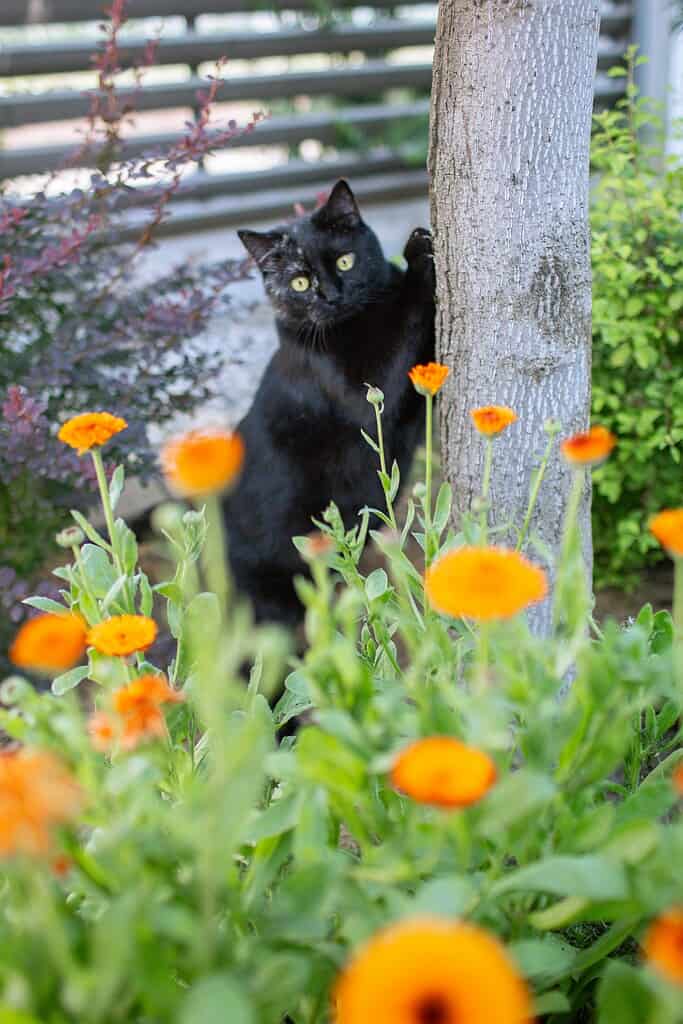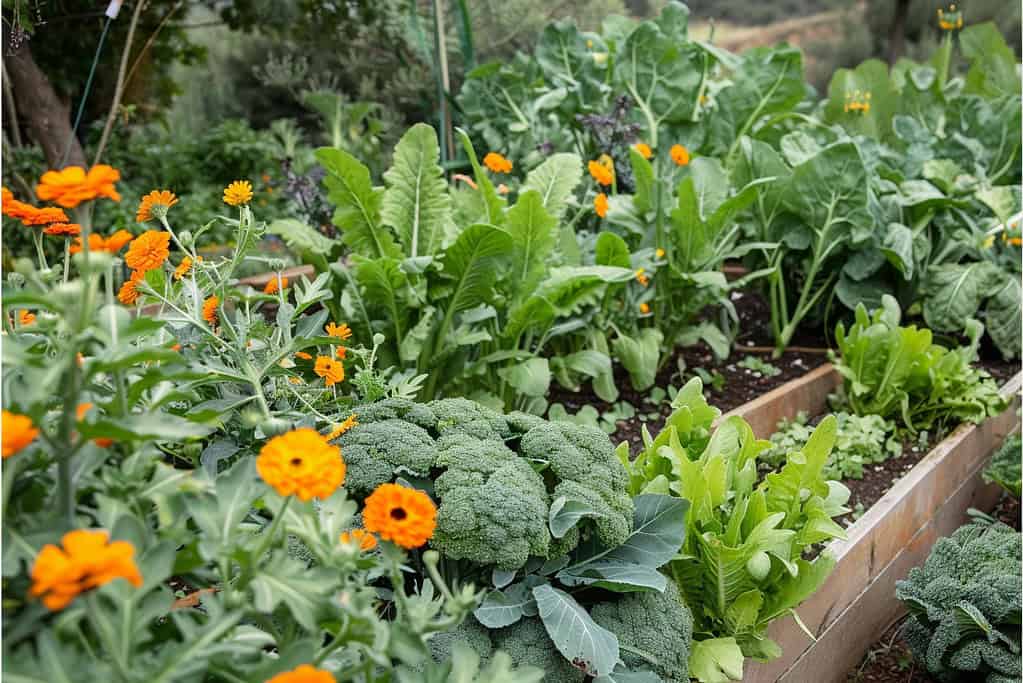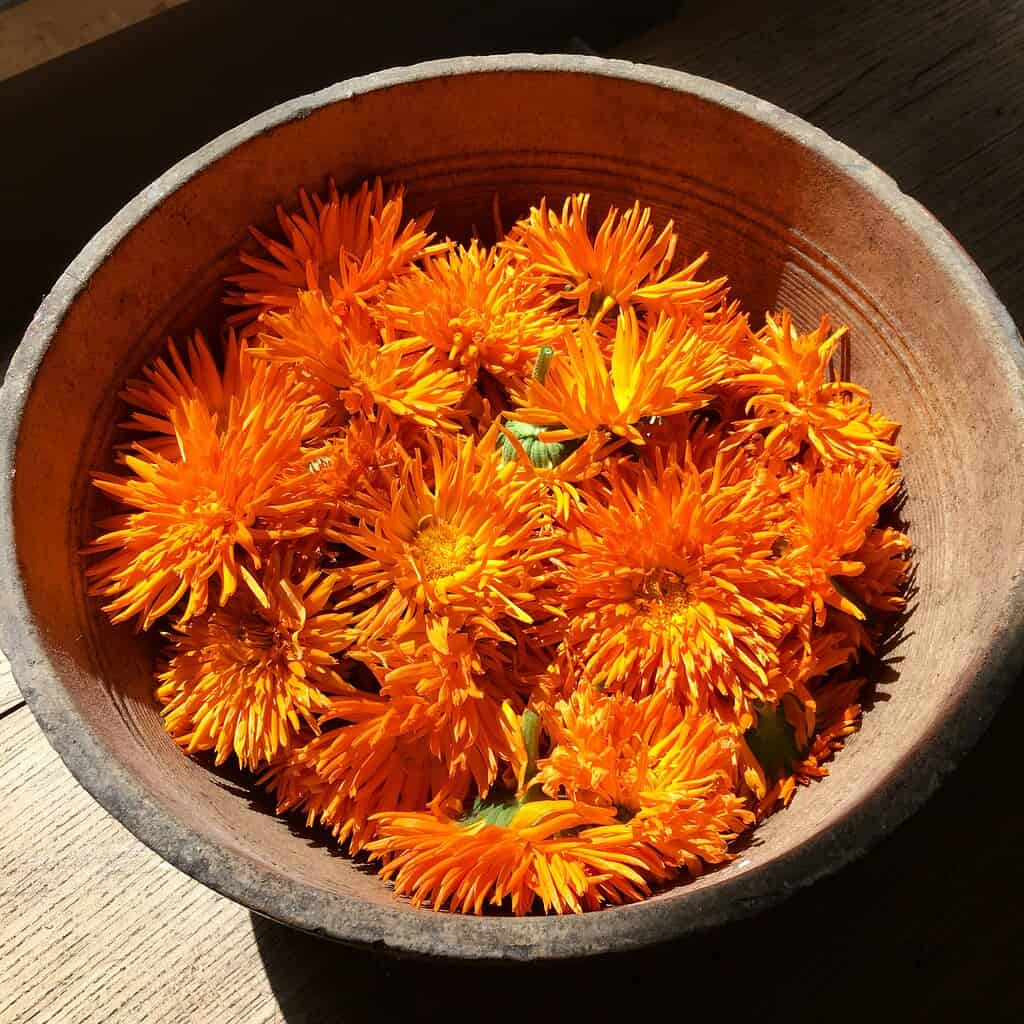Calendula is one of those cheerful little flowers that never asks for much but gives back plenty.
With its sunny orange and yellow blooms, it brightens up any garden bed, brings in pollinators, and even offers petals you can use in the kitchen or for homemade remedies (they’re often found in teas, salves, and even natural cold remedies).
The best part? It’s easy to grow almost anywhere. Whether you’re tending a backyard plot in a cool northern climate or keeping pots on a sunny balcony down south, calendula adapts and thrives.
In this guide, I’ll walk you through the simple steps for planting, caring for, and harvesting this versatile flower so you can enjoy its beauty and benefits all season long.
Calendula at a Glance
Calendula really is one of those plants that doesn’t make gardening complicated.
Once you know the basics – how tall it gets, what kind of soil it likes, and when it blooms – you’ve got most of what you need to grow it successfully.
Let’s dig into the details so you can get these bright, cheerful flowers thriving in your own space, no matter what climate you’re working with.

| Feature | Details |
|---|---|
| Botanical Name | Calendula officinalis |
| Other Names | Pot marigold, common marigold |
| Family | Asteraceae (the daisy family) |
| Plant Habit | Grows as an annual in most places; short-lived perennial in zones 9–11 |
| Size | Usually 1–2 feet tall and about as wide |
| Light Needs | Prefers full sun, tolerates light shade in hot areas |
| Soil Preference | Loose, well-drained, enriched with compost |
| pH Range | Slightly acidic to neutral (6.0–7.0) |
| Bloom Season | Spring through fall, depending on climate |
| Flower Colors | Yellow, orange, cream, pink, red, and white (depending on variety) |
| Hardiness Zones | USDA 2–11 |
| Native Range | Mediterranean region |
When and Where to Plant Calendula

This hardy annual (or short-lived perennial in warmer zones) doesn’t demand much, but a few simple guidelines make all the difference.
Best Time to Plant Calendula
In most places, you’ll want to sow seeds in early spring once the danger of frost has passed. Wait until the soil warms to at least 60°F before planting.
If you live somewhere with mild winters, you can even try sowing in fall for earlier blooms the following spring.
Ideal Sunlight for Calendula
Calendula thrives in full sun, and the more light it gets, the better it flowers.
In regions with very hot summers, though, the plants appreciate a bit of afternoon shade to prevent wilting and stress.
Best Soil for Growing Calendula
This plant is pretty forgiving, but it does its best in loose, well-drained soil that’s been enriched with compost or organic matter.
Calendula handles different soil types and pH levels without fuss, but a slightly acidic to neutral range (6.0–7.0) is ideal.
Think of calendula as a “plant it and enjoy it” flower – it will put on a good show as long as it has sun, decent soil, and a little attention in the beginning.
How to Plant Calendula from Seed
One of the reasons gardeners adore calendula is how forgiving it is to grow from seed.
Whether you prefer the control of starting plants indoors or the ease of direct sowing outside, calendula will reward you with quick growth and plenty of blooms.
Starting Seeds Indoors
For those who like to get a head start on the season, indoor sowing is a great option.
- Begin about 6–8 weeks before your area’s last expected frost date.
- Use a lightweight seed-starting mix to give young roots room to grow.
- Plant seeds in small trays or pots, keeping them about ¼ to ½ inch deep.
- Place containers in a bright window or under grow lights, and keep the soil evenly moist but not soggy. (If you need extra guidance, here’s a handy resource on how to start seeds indoors without grow lights.)
Seedlings usually appear within 5–15 days. Once they have two to three sets of true leaves, they can be hardened off and moved outside after the danger of frost has passed.
Direct Sowing in the Garden
If you prefer a no-fuss approach, calendula can be planted directly into the garden soil. This is one of the simplest methods if you’re learning how to direct sow seeds successfully.
- Wait until the soil temperature has reached at least 60°F.
- Prepare the bed by loosening the soil and mixing in compost for added nutrients.
- Scatter seeds over the surface and lightly cover them with soil.
Direct-sown calendula often establishes quickly, and because it’s so hardy, it tends to thrive even with minimal attention once it’s up and growing.
Spacing and Thinning
Good spacing is key to keeping your calendula plants healthy.
- Thin seedlings to about 8–12 inches apart once they’ve sprouted.
- If planting in rows, leave 18 inches between each row to ensure good airflow.
This spacing helps prevent powdery mildew, a common issue when plants are too close together. It also gives each calendula plant the room it needs to form a bushy, flower-filled shape.
Will Calendula Reseed Itself?
One of the delights of calendula is its tendency to self-sow.
If you leave a few flowers to mature and drop their seeds, you may find fresh calendula seedlings popping up the following spring.
Many gardeners welcome this habit, as it keeps their garden filled with cheerful blooms year after year without much extra effort.
How to Care for Calendula Organically

Calendula is one of those flowers that gives back more than it takes.
Knowing how to water, feed, and maintain it properly makes the difference between a few flowers and a season-long show.
How to Water Calendula Plants
Young calendula seedlings thrive when the soil is kept evenly moist, helping them develop strong roots.
Once the plants are established, they don’t demand much, though they still appreciate a deep drink whenever the top inch of soil begins to dry out.
It’s better to water less often but more thoroughly, as this encourages the roots to grow deeper.
Overwatering is one of the few ways to cause trouble, since waterlogged soil can lead to root rot. Well-drained soil and sensible watering are the best ways to avoid this.
Does Calendula Need Fertilizer?
Calendula isn’t a heavy feeder, and in most garden soils enriched with compost, it will grow just fine without extra fertilizer. (If you’re making your own compost, you might like learning about the Berkeley method of composting, which produces rich, garden-ready compost in just a few weeks.)
In fact, too much fertilizer (especially nitrogen) can make the plants stretch tall and spindly, leaving you with fewer flowers.
The only real exception is when calendula is grown in containers.
Potted plants lose nutrients faster through watering, so giving them a diluted, balanced liquid fertilizer once a month helps keep their energy up for blooming.
How to Prune and Maintain Calendula
Simple pruning keeps calendula plants healthy and attractive. Pinching back the tips of young plants encourages bushier growth and prevents long, weak stems.
Throughout the season, removing spent flowers, or deadheading, encourages the plant to keep producing new blooms instead of going to seed too early.
In cooler climates, a layer of mulch around the base of the plants holds moisture in the soil, suppresses weeds, and helps protect the roots from temperature swings.
Calendula Care in Hot and Cool Seasons
Calendula naturally prefers cool weather, which is why it looks its best in spring and fall. During the hottest part of summer, the plants may slow down or appear stressed.
Cutting them back lightly and offering some afternoon shade helps them recover. Often, when the temperatures dip again, calendula responds with a fresh wave of blooms that carry right into autumn.
Common Calendula Problems and Natural Solutions

Even though calendula is known for being a hardy and forgiving flower, it’s not completely immune to trouble.
With the right care, most issues stay minor and easy to manage, especially if you prefer natural or organic methods.
How to Prevent Powdery Mildew on Calendula
Powdery mildew can show up when plants are crowded too close together or when air circulation is poor. The leaves start to develop a white, powdery coating that weakens the plant over time.
The best defense is prevention: give each plant plenty of space, water at the base instead of from above, and try to avoid watering late in the evening when the foliage won’t have time to dry.
If mildew does appear, trimming back the worst-affected leaves often helps the plant recover quickly.
Controlling Aphids and Whiteflies on Calendula
Like many garden plants, calendula can attract tiny sap-sucking pests such as aphids and whiteflies, and there are several effective ways to get rid of aphids naturally if they become a problem.
These insects cluster on tender new growth, causing leaves to curl and stems to weaken.
A strong spray of water from the hose is often enough to knock them off, and repeating this every few days usually does the trick.
If the problem persists, an application of insecticidal soap made for garden use is a safe way to bring the pests under control without harming pollinators.
You don’t have to buy it either – here are some simple homemade insecticidal soap recipes you can try with ingredients you probably already have at home.
Protecting Calendula from Slugs and Snails
In damp or shaded spots, young calendula plants may fall victim to slugs and snails. You’ll notice ragged holes in the leaves or even missing seedlings overnight.
The simplest solution is to keep the garden bed tidy by clearing away mulch or debris that shelters these pests.
Hand-picking at dusk or dawn, when slugs and snails are most active, is another straightforward method.
Some gardeners also scatter crushed eggshells around their plants – a simple way of using eggshells as organic pest control – or turn to diatomaceous earth for extra protection.
Calendula is a Low-Maintenance Flower
The good news is that calendula rarely faces serious problems. It tends to bounce back quickly from minor setbacks and doesn’t require constant intervention.
By planting it with enough space, watering sensibly, and keeping an eye out for early signs of pests, you’ll find that calendula rewards you with months of blooms with very little effort on your part.
Companion Planting with Calendula

Calendula is more than just a pretty flower. In the vegetable garden, it acts as a team player, supporting other crops and drawing in helpful insects.
Knowing what to plant alongside calendula can make your whole garden healthier and more productive.
Best Companion Plants for Calendula
Calendula grows especially well alongside:
- Carrots
- Potatoes
- Brussels sprouts
- Pumpkins
- Tomatoes
- Salvia
- Lavender
- Roses
These plants benefit from the pollinator activity that calendula brings in, and the flowers help lure pests away from vulnerable crops.
Plants to Avoid Growing with Calendula
Not every plant makes a good match. It’s best to avoid planting calendula near:
- Beans
- Cabbage
- Fruit crops
Calendula may attract pests that also trouble these plants, so keeping them apart lowers the risk of problems spreading through your garden.
For more details on good and bad plant pairings, check out this expert companion planting guide.
Great Benefits of Calendula in the Garden

Calendula does double duty in the garden. Its bright flowers naturally draw in pollinators like bees, bumblebees, and butterflies, which means better pollination for nearby vegetables and fruits.
At the same time, it attracts beneficial insects such as hoverflies and ladybugs that help keep aphids and other pests under control.
Many gardeners also use calendula as a “trap crop,” letting it lure pests away from more delicate plants like tomatoes and squash. This makes calendula a quiet little helper in creating a more balanced and productive garden ecosystem.
Beyond its usefulness, calendula adds a burst of color and charm wherever it grows.
With so many varieties available – from the traditional golden-orange flowers to softer shades of cream and pink – calendula can be as decorative as it is practical.
For such an easy plant to grow, it offers a surprising number of rewards.
How to Harvest Calendula Flowers

One of the best things about calendula is how generous it is with its blooms. Once the plants get going, you’ll find flowers opening almost daily, and the more you pick, the more they produce.
Harvesting at the right time not only gives you the freshest petals for drying or using fresh, but it also encourages the plant to keep blooming right through the season.
The ideal time to gather calendula flowers is in the late morning, after the dew has dried but before the midday sun is at its hottest.
Look for blossoms that are fully open, with petals spread wide and vibrant in color. Simply snip or pinch the flower heads off just above the next set of leaves.
Drying Calendula Flowers
If you plan to dry them, spread the blooms out in a single layer on a screen or tray and set them in a dry, shady place with good airflow.
Turn them every couple of days until they feel papery and crisp to the touch. Once dried, store them in a sealed glass jar kept in a cool, dark cupboard.
Properly dried calendula holds its bright color and herbal qualities for months, ready to use in teas, salves, or even as a natural garnish in the kitchen.
How to Save Calendula Seeds
Saving calendula seeds is one of the simplest ways to ensure you’ll enjoy these flowers year after year. Instead of deadheading every bloom, let a few flowers stay on the plant late in the season.
Over time, the petals will wither and the seed head will dry out, turning tan and brittle. That’s your sign the seeds are ready to collect.
Gently pull the dried seed heads from the plant and break them apart over a bowl or tray. Inside you’ll find curved, crescent-shaped seeds that are easy to handle.
Once gathered, let the seeds air-dry for a few more days in a cool, shady spot to make sure no moisture remains. Store them in a labeled glass jar or paper envelope, kept in a dry and dark place.
Grow Calendula for Lasting Garden Beauty
Calendula is proof that gardening can be both simple and rewarding. With the right start – healthy soil, plenty of sun, and a little regular care – it will bloom steadily from spring through fall.
It not only brightens up beds, borders, and containers but also supports pollinators and pairs beautifully with vegetables and herbs.
Add in its edible and herbal uses, and you’ve got a flower that’s as practical as it is pretty.
If you’ve grown calendula before, or you’re planning to try it this season, I’d love to hear your tips and experiences. Drop a comment below and share how you use calendula in your own garden.
FAQs
How long does it take calendula to flower from seed?
Calendula doesn’t keep you waiting long. From the time you sow the seeds, you can usually expect flowers within six to eight weeks, making it one of the quickest blooms to enjoy in the garden.
Can you grow calendula in containers?
Yes, calendula grows happily in pots and window boxes. Choose a container at least 8–10 inches deep with good drainage, place it in a sunny spot, and water regularly. Since nutrients leach out faster in containers, a light monthly feeding will keep plants strong.
Does calendula survive through the winter?
In mild climates, particularly USDA zones 9–11, calendula may act as a short-lived perennial and bloom through winter. In colder areas, it’s best treated as an annual, though mulching can sometimes extend its season a little longer into the cool months.
Is calendula safe to eat?
Yes, calendula petals are edible and often used to brighten up salads, soups, and baked goods. The flowers can also be dried for teas or infused into oils and balms for homemade skin-care remedies. The leaves are technically edible too, though they’re not as widely enjoyed.
How do you keep calendula blooming all season?
The secret is regular deadheading. By snipping off spent flowers, the plant puts its energy into producing more buds instead of seeds. If plants get tired in midsummer heat, cutting them back lightly often encourages a fresh wave of growth and blooms.
Ready To Transform Your Garden?
Are you looking for the best way to layout your garden beds? Maybe you're feeling a bit stuck on how to make the most of your space?
We’ve got you covered! Check out our 101+ Garden Bed Layout Ideas for your next raised bed project. This guide is filled with creative and practical ideas that can help you design a garden that fits your style, whether you’re just starting out or have been gardening for years.
Get your copy today and get inspired to bring your gardening dreams to life.

